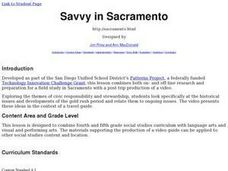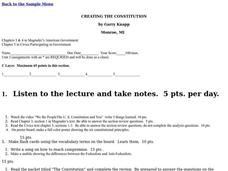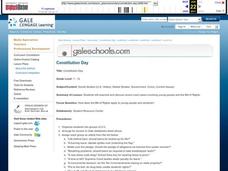Curated OER
Savvy in Sacramento
Students take a field trip to the state capital, Sacramento. Using the Internet, they explain the physical and human geographic features of the area and discuss interactions between the people of California between the time of explorers...
Curated OER
The Living Weapon
Students explore American history, military strategy and scientific discovery near the end of the World War II era. They examine the principles of the Cold War, pacifism, and the desire to keep government programs secret from the...
Curated OER
Lesson Plan: Bringing Out the Vote
Students explore voter turnout, analyzing why Americans don't vote, and citizen activism through creating community publicity about the 2004 Presidential election.
Curated OER
William Howard Taft National Historical Site
Students examine the role William Howard Taft played in American History. They analyze his background and how he got to be president. They compare qualities of leaders today to Taft.
Curated OER
Tell About South II: Poets and Prophets
Students explore the life of Richard Wright. They create a Power Point presentation to showcase Wright's journey from Mississippi to Memphis, Chicago, New York, and France and how he was an example of an African-American who moved north....
Curated OER
Publisher Skills Assessment
Young scholars complete a technology integration project using Publisher. In this technology lesson, students use Publisher to create magazine activities for the American Revolution, indigenous cultures, California missions,...
State Bar of Texas
Brown v. Board of Education
You walk each day over 20 blocks to school as a 9-year old because the color of your skin does not allow you to attend a school in your own neighborhood. Scholars use the 1954 Supreme Court case Brown v. Board of Education to investigate...
State Bar of Texas
Plessy v. Ferguson
Where did separate but equal originate and what does it mean? Scholars investigate the Supreme Court Case Plessy v. Ferguson. Using a short video clip, they analyze the impact the decision of legal segregation had on society in 1896....
State Bar of Texas
Sweatt v. Painter
Is separate but equal actually equal? The 1950 Supreme Court case Sweatt v. Painter discusses the law of segregation and inequality. Scholars investigate the impact of the case on the desegregation of public schools across the nation...
State Bar of Texas
Wisconsin v. Yoder
How far does freedom of religion truly go? The 1972 Supreme Court case Wisconsin v. Yoder introduces the concept of the free exercise clause of the First Amendment. Individuals examine the case with a short video and open discussion. To...
State Bar of Texas
Mendez v. Westminster and Delgado v. Bastrop ISD
You arrive at school only to be told you have no place there. Scholars research the Supreme Court cases Mendez v. Westminster and Delgado v. Bastrop ISD, both dealing with school segregation. Two short video clips as well as small group...
Center for Civic Education
Constitution Day Rap
Engage your class while learning about the US Constitution with this fun primary grade social studies lesson. After viewing a picture of the US Constitution, young learners piece together a US flag using stars and...
Center for Civic Education
To Amend or Not to Amend, That's Been the Question...Many Times
Looking for some ideas for how to celebrate September 17, Constitution Day? Check out a packet that focuses on the factors that are considered in the amendment process. Class members examine the amendment process and the types of...
State Bar of Texas
Schenck v. US
Freedom of speech is absolute—or is it? The Supreme Court case Schenck v. United States has learners research what free speech really looks like. A short video along with paired work creates open discussion and thought on what speech is...
State Bar of Texas
Hernandez v. Texas
What if the jury is not made up of people from your ethnicity or background—are they still considered your peers? Scholars analyze the impact the Supreme Court case Hernandez v. Texas had on jury selection across the nation. Paired...
State Bar of Texas
Tinker v. Des Moines
Freedom of speech allows anyone, even those in school, to say and do what they feel—right? The 1969 Supreme Court case Tinker v. Des Moines serves as the backdrop for a study on First Amendment rights. Scholars use a short video along...
Center for Civic Education
What Basic Ideas Are in the Preamble to the Constitution?
Introduce young historians to the US Constitution with this upper-elementary social studies lesson plan. Beginning with a general discussion about the role of government in society, young scholars go on to work in small...
Curated OER
Claudette Colvin: Twice Toward Justice
Use the historical account of Claudette Colvin to study civil rights and connect past injustices to modern issues. As learners read, they examine chapter titles, record quotes, and participate in discussion. Next, they research...
Curated OER
CREATING THE CONSTITUTION
Young scholars engage in a variety of activities aimed at strengthening comprehension of the Constitution. The activities are part of a layered curriculum and students create a portfolio for assessment.
Curated OER
Recognizing Peace
Students read the statement of Alfred Nobel and discuss the Nobel Peace Price and its criteria. They consider criteria and selection process to establish a school or community peace award. Students consider potential recipients for the...
Curated OER
Constitution Day
Pupils examine and discuss recent court cases involving young people and the Bill of Rights.They use a focus question to create the context for class discussion: How does the Bill of Rights apply to young people and students?
Curated OER
City Desk with Malcolm X
High schoolers view a film about civil rights and the role Malcolm X played in the civil rights movement. They create a timeling about the events that occured from segregation to integration. They discuss discrimination as well.
Curated OER
Music of the Civil Rights Era, 1954-1968
Learners experience the aesthetics of music and learn about freedom songs that motivated the Civil Rights activists. In this music history lesson, students learn how music can motivate and move listeners. Learners then describe how...
Curated OER
Jackie Robinson, Civil Rights Activist
Pupils analyze the life of Jackie Robinson and determine which characteristics contributed to his success as the baseball player who broke the color barrier and as a political activist.
Other popular searches
- U.s. American Civics
- Us American Civics
- Chapter 1 American Civics
- Holt American Civics
- American Civics and Activism
- Chapter 2 American Civics
- Civics American Goverment























